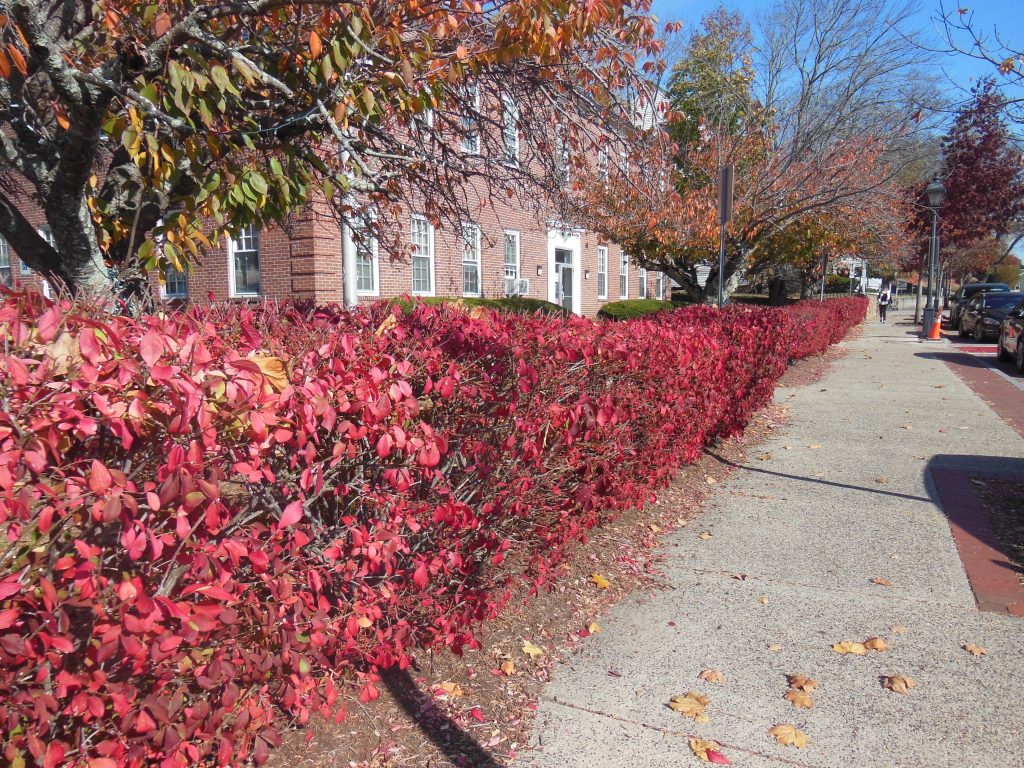
November 5, 2024 Nancy Mellen
Hingham is proud of being a “Tree Town,” and it should be. Unfortunately, we now need to stop being a town that planted invasive plants in the past and now is not removing them. To set an example for the rest of the town, Hingham needs to remove the Burning Bush (Euonymus alatus) that is bordering the Town Hall parking lots and in front of the Post Office. Burning Bush (Euonymus alatus) is unfortunately on the Massachusetts Invasive Plant List. The list of plants on the Massachusetts invasive list can be found at https://massnrc.org/mipag/invasive.htm and https://www.mass.gov/info-details/massachusetts-prohibited-plant-list . A plant being on the invasive or prohibited list means that it cannot be bought, sold, or given away in Massachusetts.
If you drive down Main Street from Hingham Square to Queen Anne’s Corner, you will see about 25 examples of Burning Bush as large shrubs or long hedges. You will see them wherever you drive in Hingham. The way you will recognize it is its bright red fall color. Most people don’t even know it is an invasive plant.
In this age of climate change, we need to be conscious of preserving our native woodlands, plants, insects, and birds all which evolved here and depend on one another. The plants on the invasive list are dangerous to our native populations because they did not evolve here, and they do not have natural predators or diseases to keep them under control. As a result, the birds or animals eat the berries, cover them with fertilizer, and deposit them in our woodlands where they out-perform the native species. Therefore, they need to be removed and controlled by us.
I am not suggesting that we give up the lovely fall red color, but I am suggesting Hingham residents save the environment by removing the Burning Bushes in our yards and replacing them with an alternative native plant, which also has beautiful red fall color. A few options for replacements are Highbush Blueberry (Vaccinium corymbosum), Arrowwood Viburnum (Viburnum dentatum), Smooth Witherod (Viburnum nudum), Virginia Sweetspire (Itea virginica), Red and Black Chokeberries (Aronia), and Large and Dwarf Fothergilla (Fothergilla major, Fothergilla gardenia).
If Hingham can get a movement going to remove these invasive plants that are causing serious damage to our woodlands, I think we will be able to progressively encourage Hingham to continue with the removal of other invasive plants, such as Japanese Knotweed (Polygonum cuspidatum) which is spreading aggressively along Beal Street, or Bittersweet which is growing up into trees in the woodlands. All of us need to get to know what is growing in our yards, and whether it is invasive or not. This information can be found by taking a picture of the plant in question with an iPhone and clicking to get more information about the picture, or downloading an app such as PictureThis for the plant identification and information. Please take an interest in the plants growing in our town and state, and encourage Hingham to do what is right by removing the invasive plants.


I’ve lived in Massachusetts for 67 years. I have yet to ever see a volunteer burning bush ever. Can someone kindly point one out to me?